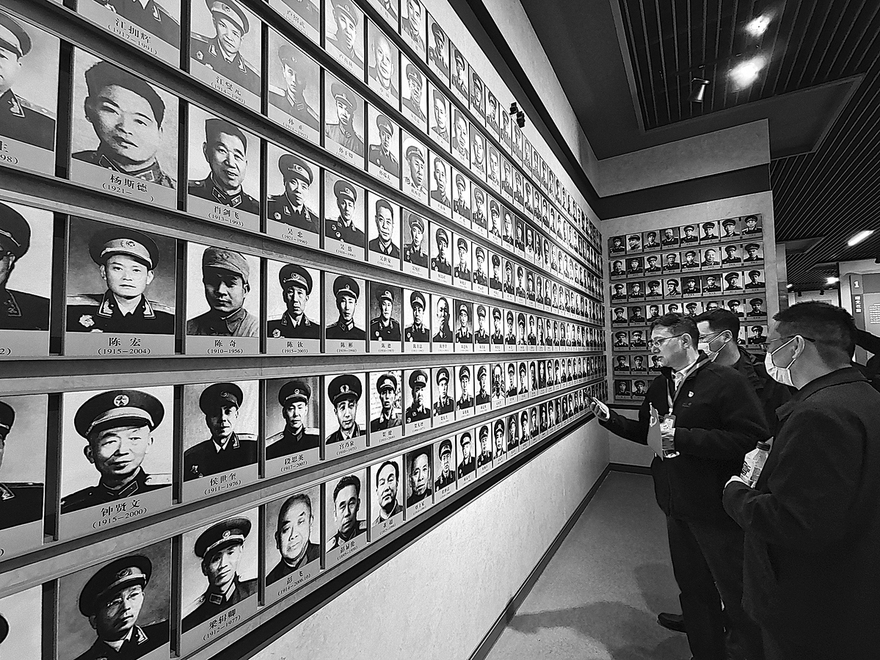
Visitors view a picture wall in the Yimeng Revolutionary History Memorial Hall in Linyi, Shandong province. [Photo via China Daily]
Centered around Yishui County in central Shandong Province, the Yimeng Mountains Revolutionary Base was one of the main Communist Party of China revolutionary bases during the late 1930s and 1940s.
Sometimes referred to as "Shandong's little Yan'an" (Yan'an is the wartime stronghold of the CPC), it became home to the CPC's Shandong branch during the War of Resistance Against Japanese Aggression (1931-1945) in 1938, and was later the site of a critical battle that paved the way for CPC's success in eastern China during the War of Liberation (1946-49).
The CPC's Yishui branch was first established in 1927, but it remained mostly underground with few members, especially in the late 1920s after fighting broke out with the Kuomintang (Chinese Nationalist Party, hereinafter referred to as "KMT"), which led to the destruction of most of the CPC's network in Shandong.
In 1936, the CPC sent a representative named Li Yu (1906-86) to rebuild its network in the province. When the Japanese invasion entered full swing in July 1937 and captured major cities in Shandong, Li helped form a guerrilla detachment under the Eighth Route Army in January 1938 and led uprisings against the invaders.
Following a directive from the leadership, a plan to establish a revolutionary base was tabled at a provincial Party meeting in May, which was headed by Guo Hongtao (1909-2004), the then secretary of the CPC branch in northern Shaanxi. Guo arrived in Shandong from Yan'an, Shaanxi province, where the CPC had assembled after the Long March.
Several locations in the province were chosen as places to push forward the cause over the following months, including Yishui in the Yimeng Mountains. Meanwhile, the regional CPC committee relocated to a Catholic church in Wangzhuang Town in November, as the CPC enjoyed local popularity in the town and its German-built church was more likely to be spared in the event airstrikes were ordered by the Japanese.
In December 1938, the CPC guerrilla forces in the province regrouped as the Eighth Route Army Shandong Column, which had about 24,500 soldiers. In March, part of the Eighth Route Army was sent to Shandong to help establish the base. The War of Resistance reached a strategic stalemate in October 1938, when the Japanese slowed military operations and increased their attempts to get KMT officials to surrender. The Japanese also shifted some of their focus to wiping out resistance forces in the occupied territories, launching a "cleanup" campaign in Yimeng in June 1939. The KMT passively resisted the Japanese while actively restricting and blockading the CPC.
Faced with a difficult situation, the CPC chose to continue to fight by uniting the people and establishing regional governments. In July 1940, an area-wide congress was held and a wartime work committee was elected to act as the highest regional government, marking the official establishment of the Yimeng Mountains Revolutionary Base.
From 1939 to 1941, the Japanese and their puppet armies organized dozens of "cleanup" campaigns against the base. At the same time, severe famine was afflicting many parts of China, including Yimeng. The base shrank in the face of blockades, but the CPC launched a round of guerrilla warfare and managed to survive by relying on the public for support.
The Ditty of Yimeng Mountains, a song composed at the time that celebrated the area's natural beauty and boosted morale by revealing KMT-backed plots against the CPC, has subsequently become one of the most well-known folk songs in the country.
The CPC sent Liu Shaoqi (1898-1969), who would later become chairman of the People's Republic of China, to oversee operations in April 1942. Rent and interest relief policies were adopted, and training sessions were organized for new Party members. By autumn 1943, the base's most difficult times were behind it as production began to recover.
In March 1944, the Yimeng base launched an offensive against Wu Huawen (1904-62), a former KMT general who, like many of his troops, surrendered to the Japanese in 1943, which led to the KMT government being forced out of Shandong later that August. The offensive marked the start of a counterattack organized by the base, which was gradually able to link together separate CPC-controlled areas in Shandong.
By the time Japan surrendered in August 1945, a major swathe of Shandong was under the CPC's control.
Yimeng also played a crucial role in the War of Liberation, as CPC military commander and later foreign minister Chen Yi (1901-72) and Su Yu (1907-84), who later served as PLA Chief of General Staff, oversaw the Menglianggu Campaign, the battle that turned the tide in eastern China, from the base. During the campaign, the 74th Division, one of the best in the KMT and equipped with advanced American weaponry, was wiped out in Menglianggu, some 30 kilometers south of the base's core area in Wangzhuang.
Copyright ©1997- by CRI Online All rights reserved